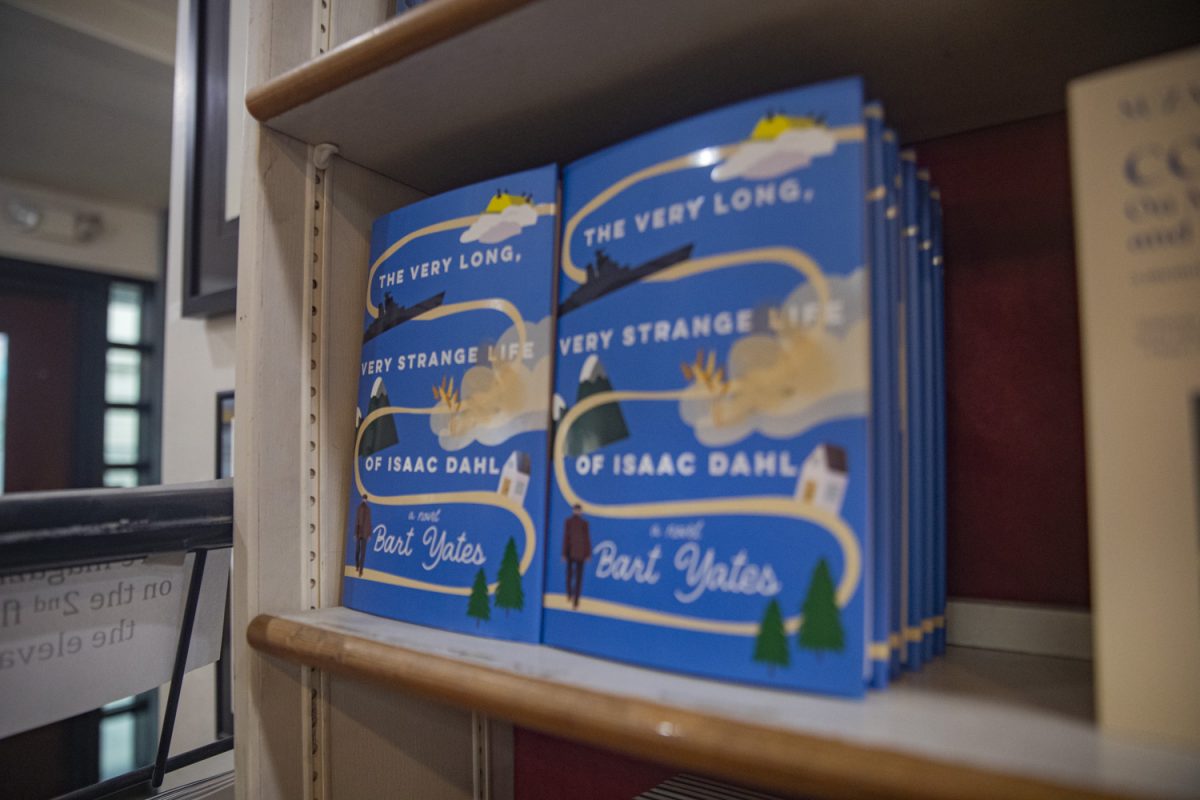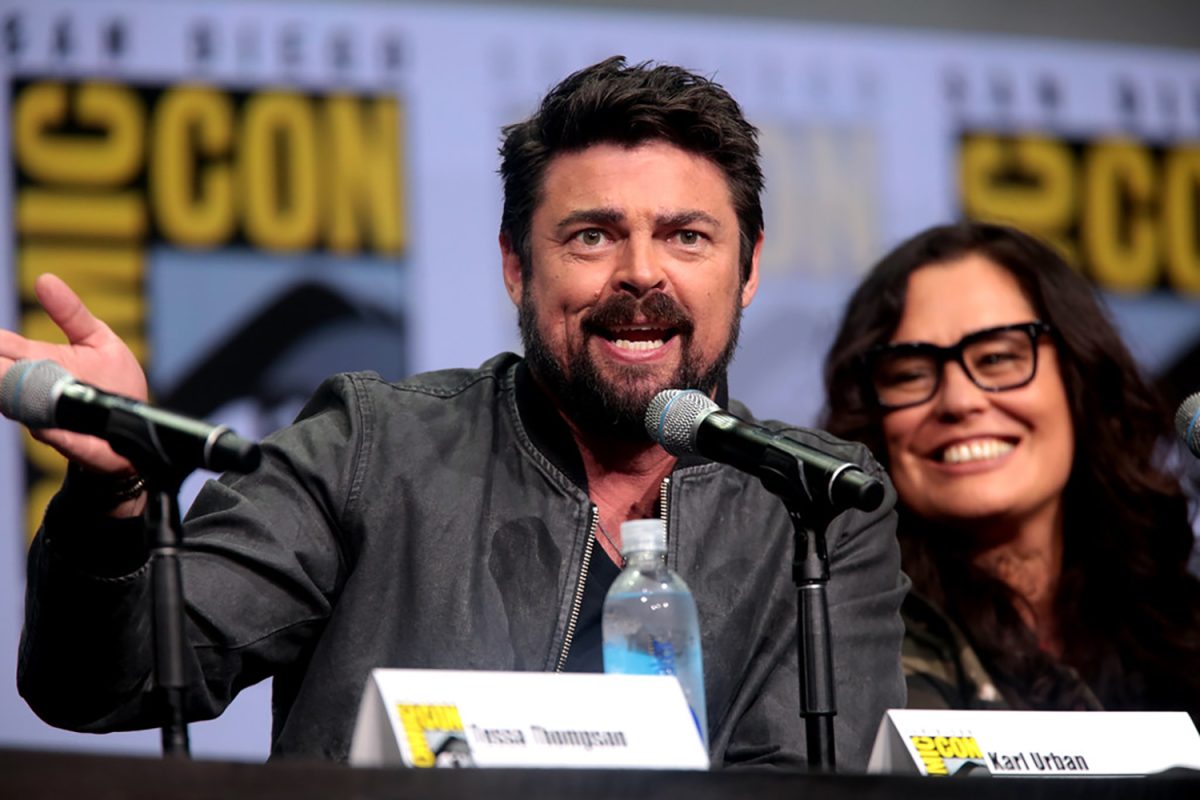
“A room with a view” has a whole new meaning at the Theater Building this weekend. Thayer Theater has been filled with dozens of deep blue windows flying at all angles, some with glass, some mere frames. Each paned window emits a pale golden light, as though a nearly set Sun is gifting the space with its last shimmering rays. The stage is set for performances of Crescendo, this year’s Partnership in the Arts production.
“[The window design] arrived because we are looking for how to create a space,” said Matteo Destro, an Italian artist and mask maker and is one of the partners for Crescendo with Paola Coletto. “Before windows, there is space ― how we can create a space the actors can play in. The goal is not symbolism, we just create dynamic movement in the space. You make a sculpture in the space.”
Together, with Matteo’s wife Coletto, who performs in the show, they traveled from Italy with his masks.
The two artists are astounding to observe. Coletto commands respect. A short woman, she stands almost shockingly vertical, elongating her frame until her silver hair seems to nearly touch the ceiling. She seems continually at ease, in control of the situation, as though nothing can touch her.
Destro is a bit more animated. He gestures close to everyone’s face, using the universal language of movement to avoid any miscommunication. He is boisterous, enthusiastic, and welcoming.
Over the past weeks it is clear the pair have become close to their cast and crew. Before rehearsal begins, an actor begins a slow waltz with Coletto, saying she is helping him warm up as he dips her low to the ground.
The time before rehearsals are nearly as important as the rehearsals themselves, preparing the bodies for the work they are about to do. In a show in which many of the principal roles are masked, as in Crescendo, the movements must be precise, a well-choreographed dance heightening each scene. Particularly if you tower above everyone else in the space.
The show opens with an actor on 7-foot stilts in a dingy, brown-splattered blue coat swept out wide to hide five sets of feet scuttling forward, welcoming the audience to the School of Education. As he barks restrictive school rules at the audience, most notably to turn off cell phones, he travels the width of the stage, depositing the masked actors he carries along with him under the floor-length garment. He moves to the right of the stage and the hidden actors appear, pushing, running, jumping, and climbing.
“The universal theme is the growing up of a child,” Destro said. “It is a same throughout the world. The child learns the first part of her or his life, 5, 6 years, through play. After that, structure is imposed with limited time, and the learning is not through play but through the passage of information. The question is why this happens. This is a story about that. We discovered that the system that is used for the school, the time and the space, is the same with the prison and mental hospitals.”
That simple question — why education changes from playing to lecturing — was the initial spark for Crescendo.
“We had a question but not the answer,” Coletto said. “There’s a difference between having something to say and having something to explore. The first thing was the masks and the music, and then we started to look at what would be an interesting area that we wanted to explore, and that’s where education came into play.”
University of Iowa theater Assistant Professor Paul Kalina was the first person at the university to be interested in these particular masks. When visiting Coletto in Italy three years ago, she took him to visit several mask makers, but only Destro’s had a lasting effect.
“Everybody else was pretty much copying the old, pretty much following the classic comedia, but [their masks] didn’t really speak to me,” said Kalina, who will perform in the show. “Then I saw what Matteo was doing and how he was trying to find the architect of what was relating to theater today so ‘mask shows’ would actually have an impact.
“Mask work, when it’s done well, the mask and the performer meet, but then there’s also the distance between the audience and the mask. The mask is not necessarily human, so they don’t have to relate to it; they can just sit, and observe, and be open to thoughts, and feelings, and emotions that they may not be if they were trying to relate to it. [Destro is] constantly pushing it, looking for ways to evolve the form. I have not seen anything like it in all the masks I saw in Italy or in all my years working with masks. I have not seen like this, the power that these bring.”
The masks, covering the actors down to their mouths, make them seem almost faceless. They have small details — a red- and white-striped hair ribbon, makeup lining their eyes, an orange flower above one ear — that ensure you they are humans, just not as you’ve seen them. The hair is the most realistic element, the faces becoming contorted and exaggerated, eyes sloping with extra flesh until they’re nearly closed, ears hanging down past the chin.
The anonymity the masks allows them to switch between characters — students, teachers, principals, presidents. No one in the cast is billed as a specific role because, as in life, they all play a variety of parts.
“You’ll see at the beginning these masks playing like children,” Kalina said. “That’s what these masks are doing; they’re switching and playing different roles at each point. They reflect the adults — and it’s through an innocence. It allows us, rather than banging someone over the head with a statement, to put this idea out there. The masks go on a journey, but it’s not linear in any way.”
The characters, Coletto said, recreate the world around them after watching it from the outside. It is as if a child today were playing house with friends and, deciding to be the parent, imitated her or his own mother or father. There is no real plot in the play; instead, it focuses on the show’s unique universe and how these masked characters navigate it.
“It is not a story, meaning this happens and then this happens,” Coletto said. “It’s an observation — let’s say observation for lack of a better word — on the field of education. After that observation, we have a replay of those events. It’s very difficult to identify a plot.”
Destro is not worried about that lack of plot, though, as he believes “each person in the audience will build a personal plot.”
“If you want to recognize real characters and real life, you won’t find it,” he said. “You don’t see the characters because they are fantastic, but they play what we are.”
The mixture of characters will likely create a variety of audience reactions, which Destro and Coletto eagerly anticipate.
“By offering it without giving any opinions, without pushing any agenda, each one of [the audience members] will make up her or his own observations,” Coletto said. “That’s not our job, to tell you what to think about it. We don’t like that — I don’t want that responsibility. When you do that, you actually zero out the experience of theater, because there’s nothing left for me as an audience. I’m left watching TV. I don’t need a brain, I need a Coca-Cola. What I’m interested in is creating a space where you can be in it and formulate your own opinion.”
THEATER






